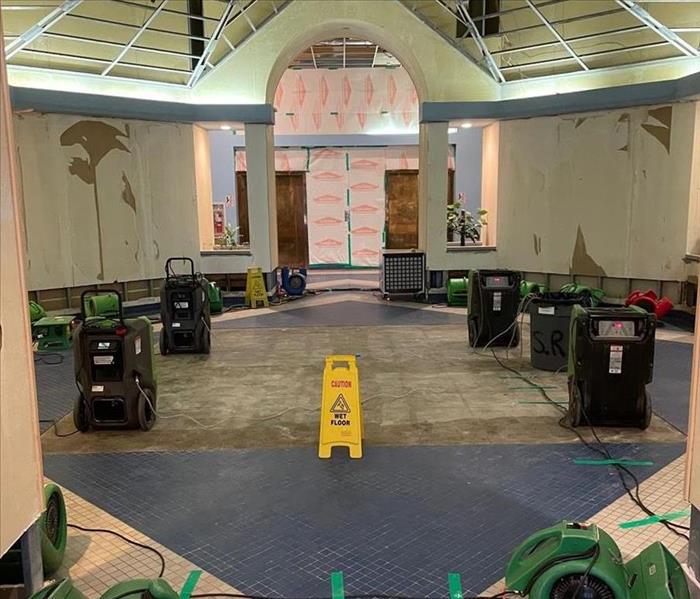Commercial Building and Water Damage
5/17/2024 (Permalink)
Water damage in commercial buildings is a prevalent and costly issue, often resulting from water pipe leaks, appliance failures, and other sources. The impact of water damage can vary, but it can escalate significantly in larger, more critical properties. Therefore, proactive measures are essential to prevent water leaks.
Advancements in the Internet of Things, particularly in the water leak sensor market, have introduced high-performance solutions for leak prevention. Building owners and facility managers must make informed decisions about adopting these technologies. Insurance professionals should also be knowledgeable about water leak detection equipment to help mitigate the substantial annual costs of water damage claims, which amount to approximately $2.5 billion in the US.
HVAC Failures
HVAC systems, especially air conditioning units, are common sources of water leaks due to issues such as clogged drains, frozen evaporator coils, or malfunctioning condensate pumps. Regular cleaning of dirt and debris is crucial to prevent these problems.
Hot water systems and heaters, which are widely used in commercial buildings, can cause significant damage when they fail. Underfloor heating systems are becoming increasingly popular due to rising environmental and energy efficiency standards for new constructions. For instance, an HVAC unit leak in a manufacturing plant resulted in over 12,000 gallons of water loss, costing around $4 million in lost revenue and clean-up.
IoT systems offer robust protection against such incidents. Leak detection sensors placed around critical HVAC components can provide early warnings, while temperature sensors can monitor heating and cooling mechanisms. Additionally, gas sensors can detect refrigerant leaks, which are hazardous to both people and the environment.
Plumbing Leaks
Frequent use of pipes, toilets, baths, and sinks makes them prone to leaks. Even a small crack can lead to significant water loss and damage, particularly in multi-residential buildings, hotels, and other hospitality venues. Toilets are a common source of interior water damage, accounting for nearly 1 in 6 incidents.
Leaks can substantially increase water bills and repair costs, leading to business interruptions and downtime, especially if residents need to be relocated during repairs. Water detection sensors, designed to detect minimal water presence, can be applied around pipes, joints, seals, and valves. Complementary flow sensors can monitor for clogs or pressure issues in the plumbing system.
Appliance Leaks
Washing machines, dishwashers, and water heaters often leak due to aging parts or clogs. These leaks are particularly challenging because they typically occur while the appliance is running, rapidly causing extensive damage. Regular maintenance and timely replacement of parts are crucial to prevent leaks.
Water leak detection sensors can alleviate the uncertainty of waiting for major leaks, ensuring early detection and intervention.
Roof and Wall Leaks
Roof leaks are the most common type of water leak in commercial buildings, influenced by weather conditions and maintenance issues. Flat roofs are particularly susceptible due to water pooling. Walls, exposed to the elements and containing various features like lights, HVAC units, and window frames, are also vulnerable to leaks.
IoT water leak detection sensors can be integrated into roofing materials or mounted around window and door frames to monitor for leaks. Sensors in drains and gutters can alert to blockages, while structural health monitoring sensors can detect water damage or pooling by assessing the levelness and integrity of walls and roofs.
Flooding, Groundwater, and Sewage
Flooding and sewage backups are complex and messy issues. While excessive rain and river overflows are challenging to predict and control, IoT solutions can help detect flooding near bodies of water. For sewage blockages, flow sensors and water level sensors can monitor for issues, particularly in large-scale buildings with high water use. Smart valves, such as automatic shut-off valves, can prevent blockages and backflow, mitigating potential damage.
For over 20 years, SERVPRO® water detection sensors has been the leading solution for water damage restoration in Cobb County. Their team of highly trained professionals utilizes state-of-the-art equipment and advanced techniques to quickly and efficiently mitigate water damage in both residential and commercial properties. With a deep understanding of the local climate and unique challenges faced by Cobb County residents, SERVPRO offers tailored solutions that ensure comprehensive recovery and restoration. Their prompt response time, commitment to customer satisfaction, and extensive experience make them the trusted choice for homeowners and businesses alike, providing peace of mind and reliable results in the face of water damage.






 24/7 Emergency Service
24/7 Emergency Service
